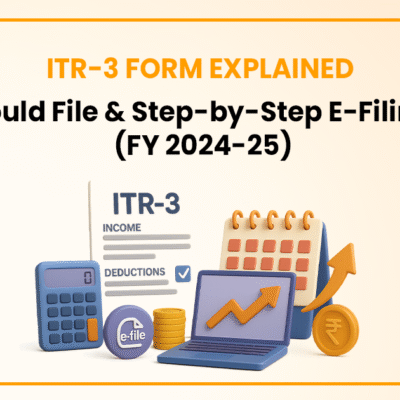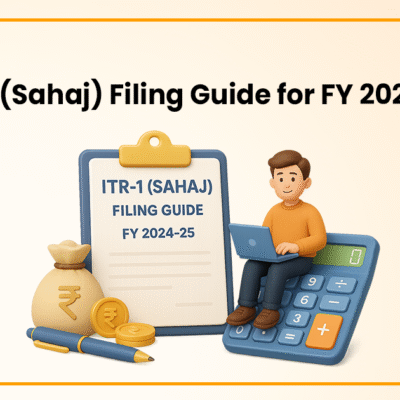ITR-2 Guide 2025: Eligibility & E-Filing Steps
For many of us, tax season brings a familiar mix of anticipation and apprehension. If you are an individual or a Hindu Undivided Family (HUF) with income flowing from your salary, a rented property, or even from smart investments like stocks and real estate, you are likely acquainted with ITR-2. This form is specifically tailored for taxpayers who do not have income from a business or profession yet deal with the intricacies of capital gains. While it might seem like a maze of sections and schedules at first glance, filing ITR-2 accurately and efficiently is entirely achievable. In this comprehensive blog, we will walk you through every step for FY 2024-25 (AY 2025-26), transforming a potentially daunting task into a manageable one. Ready to conquer your ITR-2?
Eligibility to file ITR 2
For many individuals and Hindu Undivided Families (HUFs), the answer is ITR-2. This form is specifically tailored for those of us who are having income from different income sources other than the income profits from a business or profession.
You need to file ITR-2 if you earn income from the following resources:
- Income from Salary or Pension
- Income derived from house property
- Income earned as a Capital Gains or Capital Losses arises including both long-term gains/losses and short-term gains/losses.
- Income received from Other Sources, which includes winnings from lotteries, bets on racehorses, and other legally recognized forms of gambling
- Payment exceeding Rs 5,000 from agricultural activities
- Foreign Income or ownership of Foreign Assets
- Having residential status as a Resident Not Ordinarily Resident (RNOR) or a Non-Resident as per the provisions of the Income Tax Act.
Important Consideration - There are some additional scenarios where ITR-2 becomes mandatory: if your total income from abovementioned sources exceeds ₹50 lakh, or if you are holding a directorship in any company or have made investments in shares of an unlisted company. In these cases, individuals must use ITR-2 (even salaried individuals).
Who is not Eligible to File ITR 2?
- Individuals or Hindu Undivided Families (HUFs) earning Income from business or profession.
- Individuals who are eligible to fill out the ITR-1 form (Sahaj)
Essential Documents for ITR-2 Filing
The following documents are required to file ITR 2:
Your Salary Blueprint: Form 16
This cornerstone document, provided by your employer, lays out your salary income and the tax already deducted (TDS). It is your primary reference for employment earnings.
TDS Beyond Salary: Form 16A
If you have earned interest on fixed deposits, recurring deposits, or even certain savings accounts where tax has been deducted at the source, Form 16A is your go-to. The entities deducting the tax will issue this form.
The TDS Verification Hub: Form 26AS
Consider Form 26AS as your personal tax statement. You can download it from the e-filing portal to cross-verify all TDS entries—from your salary to any other income where tax was deducted. It is an important tool for ensuring accuracy, especially about tax deducted at source.
Your Rent Records: Rent Receipts
For those living in rented accommodation, keep your rent receipts ready. These are crucial for calculating your House Rent Allowance (HRA) exemption or claiming deductions under Section 80GG.
Capital Gains Statements
If you have traded into shares or securities, you will need a clear summary or a profit/loss statement from your broker. This helps accurately compute your capital gains or losses for the financial year.
Bank Documents
Your bank passbook and Fixed Deposit Receipts (FDRs) are important for informing you about all your interest income from savings accounts and fixed deposits.
Property Income Documents
For those receiving rent from a property, collect documents detailing tenant information, records of local taxes paid, if any and any interest paid on borrowed capital for the house property. These are key for calculating your "Income from House Property."
Loss Documents
You will need relevant documentation for current-year losses. For past losses, a copy of your ITR-V from that specific year is a must.
Your Tax-Saving Portfolio: Investment Proofs
The proofs for your tax-saving investments include receipts for claims under Section 80C (like PPF, life insurance, ELSS), Section 80D (medical insurance premiums), Section 80G (donations), and Section 80GG (rent paid without HRA benefits). Each one helps you reduce your taxable income.
How to Submit Your ITR-2: Choosing Your Filing Path
Once you have gathered all your documents and prepared to file your ITR-2, the next step is submission. The Income Tax Department offers a couple of avenues for this, primarily split into offline and online modes, catering to different needs and preferences.
Offline Filing
If you are a taxpayer who is 80 years of age or older, then you can submit ITR-2 offline. This means you can submit a physical paper return or a bar-coded form directly to the Income Tax Department. Once you successfully submit the form, you will receive an acknowledgement as proof of your filing.
Online Filing
In the process of online filing of ITR 2, you can submit all the required information electronically, with or without a digital signature. After completing the file ITR 2 online, you can verify the return through Return Form ITR-V. If you submit ITR 2 for salaried employees electronically with a digital signature, you will receive the acknowledgement on the registered email ID.
Your Step-by-Step Guide to Filing ITR-2 Online
Filing your ITR-2 does not have to be daunting. The Income Tax Department of India's e-filing portal makes the process systematic and manageable. Here is a clear walkthrough to help you navigate your ITR-2 submission:
Logging In and Selecting Details
You have to visit the official Income Tax India website and log in using your credentials. Once inside, you will be required to select the correct assessment year for your filing. You have earned the income. You will also choose your filing mode, which for most will be "Online." Next, confirm your assessee status; ITR-2 is specifically for individuals and Hindu Undivided Families (HUFs), and the system might even pre-fill this for you.
The Core Details
Now, select the ITR-2 form from the available options. Once it is enabled, you will begin entering your information. This includes stating the reason for your filing, confirming all your personal details, validating your bank accounts, and specifying your nature of employment, among other things. Accuracy is key here, so double-check every figure and ensure no details are missed.
Declaring Your Income and Deductions
Here you are required to provide the breakdown of all your income sources. This includes your salary, any capital gains, rental income, and income from other sources. Fill in all the necessary fields precisely, making sure you have all your supporting documents ready. Do not forget to complete any applicable schedules within the form.
Following your income declarations, you will move on to specifying your eligible deductions. These are the tax-saving claims you can make under various sections of the Income Tax Act, such as investments, insurance premiums, or home loan interest. Choose the appropriate deductions from the dropdown menus to calculate your taxable income.
Calculating Your Tax and Finalizing Submission
The system will automatically calculate your total tax liability based on the income and deductions you have entered. It is important to make sure that your TDS (Tax Deducted at Source), TCS (Tax Collected at Source), and Advance Tax details are correctly specified from your Form 26AS to get an accurate calculation.
Before submitting, you will need to validate the ITR-2 form using the validation criteria provided on the income tax website. This step ensures your form is error-free. Once validated, you can generate the JSON file for online submission.
Verification and Acknowledgement
After successfully uploading the JSON file, the final crucial step is to verify your return. You have several convenient options for this, including using an Electronic Verification Code (EVC), an Aadhaar OTP, or even a digital signature. If you do not opt for the electronic verification process, you will be required to send a signed physical copy of the ITR-V to the Centralized Processing Center (CPC).
Once the verification is done, the income tax department will provide an acknowledgement receipt, which will be sent to your registered email address. Make sure to save this acknowledgement for your records.
Due Date for ITR-2 Filing
In the case of eligible persons (individuals and Hindu Undivided Families) who do not require to get audited, the last date for submission of ITR-2 for the financial year 2024-25 (assessment year 2025-26) is July 31, 2025.
In case the last date is missed, you can file a belated return by December 31, 2025. Now, the taxpayers are having the option to file an updated return up to four years from the end of the relevant assessment year.
Key differences between ITR 2 and ITR 3
Feature
ITR-2
ITR-3
Primary Income Source
No income from Business or Profession
Income from Business or Profession (Proprietary, Professional, Partnership)
Capital Gains
Yes, can report capital gains
Yes, can report capital gains
Multiple House Properties
Yes, can report income from multiple house properties
Yes, can report income from multiple house properties
Foreign Income/Assets
Yes, if applicable
Yes, if applicable
Director in a Company
Yes
Yes
Unlisted Equity Shares
Yes
Yes
Presumptive Taxation
Not applicable
Not applicable (unless turnover exceeds limits for ITR-4 eligibility)
Complexity
less complex than ITR-3, as it does require business accounting details
More complex, requires detailed business/professional accounting information
ITR 2 Filing: Your Essential Takeaways for a Smooth Tax Season
ITR 2 is for individuals and HUFs with income from salary, multiple house properties, capital gains, foreign assets, or other sources like lottery winnings, and those with total income exceeding ₹50 lakh. You cannot file ITR 2 if you have business/professional income or are eligible for ITR 1. The online filing process involves gathering essential documents (Form 16, 26AS, capital gains statements, etc.), filling in details on the e-filing portal, computing tax, and then submitting and verifying your return (e.g., via Aadhaar OTP) before the July 31st due date. Always ensure accuracy and keep all supporting records.

Legal Window, as a team of experts and professionals, can help you in timely compliance with ITR requirements. Legal Window ensures the accuracy of your ITR 2 filing and protects you from non-compliance and provides ease in smooth ITR filings.
LegalWindow.in is a professional technology driven platform of multidisciplined experts like CA/CS/Lawyers spanning with an aim to provide concrete solution to individuals, start-ups and other business organisation by maximising their growth at an affordable cost. Our team offers expertise solutions in various fields that include Corporate Laws, Direct Taxations, GST Matters, IP Registrations and other Legal Affairs.
- Capital gains tax filing India, Documents required for ITR 2, File ITR 2 online India, How to file ITR 2 online, Income tax filing help India, Income tax return form 2, ITR 2 eligibility criteria, ITR 2 filing AY 2025-26, ITR 2 vs ITR 3 difference, ITR filing last date 2025, ITR for salary and capital gains, ITR form for multiple house property, LegalWindow ITR filing assistance, Step-by-step ITR 2 filing, Who should file ITR 2
Categories
- Agreement Drafting (23)
- Annual Compliance (13)
- Change in Business (37)
- Company Law (150)
- Compliance (90)
- Digital Banking (3)
- Drug License (4)
- FEMA (17)
- Finance Company (42)
- Foreign Taxation (9)
- FSSAI License/Registration (15)
- GST (124)
- Hallmark Registration (1)
- Income Tax (214)
- Latest News (36)
- Miscellaneous (170)
- NBFC Registration (8)
- NGO (18)
- SEBI Registration (6)
- Section 8 Company (10)
- Start and manage a business (27)
- Startup/ Registration (134)
- Trademark Registration/IPR (48)
Recent Posts
- Major Upgrade: Breaking Down GST 2.0 September 15, 2025
- New Income Tax Bill 2025 August 27, 2025
- ITR-3 Form Explained: Who Should File & Step-by-Step E-Filing Guide (FY 2024-25) June 25, 2025
All Website Tags
About us
LegalWindow.in is a professional technology driven platform of multidisciplined experts like CA/CS/Lawyers spanning with an aim to provide concrete solution to individuals, start-ups and other business organisation by maximising their growth at an affordable cost.

![[ ethics for chartered accountants, professional ethics for company secretaries, ethical dilemmas faced by CAs in India, ethical issues in CS profession, CA code of conduct ICAI, CS code of conduct ICSI, pressure on CAs from clients, integrity in accounting profession, objectivity in auditing, confidentiality in CA profession, independence in accounting, due diligence for chartered accountants, ethical challenges for company secretaries, aggressive tax planning India, balancing ethics and client demands, financial statement manipulation India, ethics in tax consultancy, legal obligations vs client confidentiality, compliance vs client pressure, professional misconduct CA CS India ]](https://legalwindow.in/wp-content/uploads/who-should-file-ITR-2blog-cover-image-2.png)







